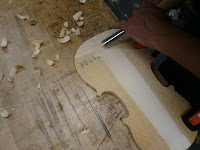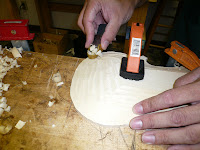I apologize for the interruption in progress on my violin blog. I needed to travel to
Welwyn Garden City in England to see my niece Leslie and her family and offer a helping hand with their move and unpacking.
Welwyn Garden City was a planned city begun after WWI and is Northwest of London. The urban plan was to provide integrated green spaces with commercial and residential areas. Industrial parks were limited to separate quadrants. The planning prevented the development of urban blight, slums and overcrowding.
Below is a view of their new home taken from the garden bench at the rear of the house.
 The center of the house was originally constructed in the 1920"s. Wings were later added at both ends and the Dining room was extended forward toward the Garden.
The center of the house was originally constructed in the 1920"s. Wings were later added at both ends and the Dining room was extended forward toward the Garden.Below is the store front of Hill and Company String Shop in The Very Old Village of
Welwyn. In 2008 I had visited my niece in St.
Albans and had learned of this string shop.

I was very curious about it since the name Hill in my mind was associated with the famous William E. Hill and Sons of London. The rosin I have had since childhood was under their label. I later learned of their fame for expertise in restoring and appraising great violins. As well they made fine string instruments and bows. Furthermore, they had donated the great collection of 16
th and 17
th century string instruments including the oldest Amati and the
Strad Messiah to the Ashmolean Museum in Oxford.
W.E. Hill and Sons ceased to exist in 1992. Last year I looked up their original location at 140 New Bond Street and discovered that their business address and facade no longer existed. So I was curious as to whether or not this Hill and Co. was in any way related.

Above is the front counter at Hill and Company String Shop in
Welwyn Village
On the cabinet next to the violin in a cast metal stand are early 1900's photos of the famous
Mirecourt Violin district in Paris.
Below are Charlotte, Marguerite, and Leslie at Hill's. This was a trip to further inspire 4 year old Charlotte's interest in the violin.
Hill's had a lovely sounding 1/8
th size violin that was much better than the 1/16
th size violin Charlotte was using. Leslie rented the new one on this trip.
While we were their I had the chance to meet the proprietor, Howard Hill. I learned that while he and his father who started the string shop were not related to W. E. Hill he had worked for them 12 years and
acquired a great deal of his knowledge on restoration from that experience. Restoration is his primary focus rather than making violins.

Above is a framed 1976 poster
commemorating Siegbert Reinhard's Paper Sculpture Titled "Rehearsal" of a string quartet. (I have a cutout art piece of this at home. Small world isn't it.)
This is the collection of string instrument for sale in the audition room

Below I am trying out a 1746 violin by French
luthier Pierre Saint-Paul(1728-1746). He worked in Paris on Rue St. Andre. This was a remarkably powerful and resonant instrument. The G and D strings had warmth and power. I later deduced that this was probably an example of one of his smaller Amati models. I had some difficulty with intonation since it was smaller than the
Strad model my current German violin is based on.
 I stopped by Indianapolis Violins to photograph the progress Ben had made on the top and back arches. Also, Dr. Samuel Siurua's friend, Neil Handley, was to drop off Sam's Mathew Furber 1830's violin for any new fittings and adjustments it might need.
I stopped by Indianapolis Violins to photograph the progress Ben had made on the top and back arches. Also, Dr. Samuel Siurua's friend, Neil Handley, was to drop off Sam's Mathew Furber 1830's violin for any new fittings and adjustments it might need. This second shot gives a clearer view of the height of the top arch.
This second shot gives a clearer view of the height of the top arch. Here Ben displays the maple back to show the beautiful flaming .
Here Ben displays the maple back to show the beautiful flaming . The shape and height of the back arch are more clearly seen in this photo.
The shape and height of the back arch are more clearly seen in this photo. To my surprise Ben decided to layout the F holes. He began by locating and drawing a horizontal line extending across the top from immediately under the bottom of the purfling at the point the corners turn up. Next he carefully located the center line along the line of the seam where the two pieces of wood were originally joined. Finally checking the photographs and measurement of the Medici and Cremonese Strads he decided on the closest measurement from the two violins that fit the proportion and look of my top. At that point using both a ruler and the calipers he marked and the drew in the two vertical lines against which he will lay the Strad F hole template.
To my surprise Ben decided to layout the F holes. He began by locating and drawing a horizontal line extending across the top from immediately under the bottom of the purfling at the point the corners turn up. Next he carefully located the center line along the line of the seam where the two pieces of wood were originally joined. Finally checking the photographs and measurement of the Medici and Cremonese Strads he decided on the closest measurement from the two violins that fit the proportion and look of my top. At that point using both a ruler and the calipers he marked and the drew in the two vertical lines against which he will lay the Strad F hole template.


















































